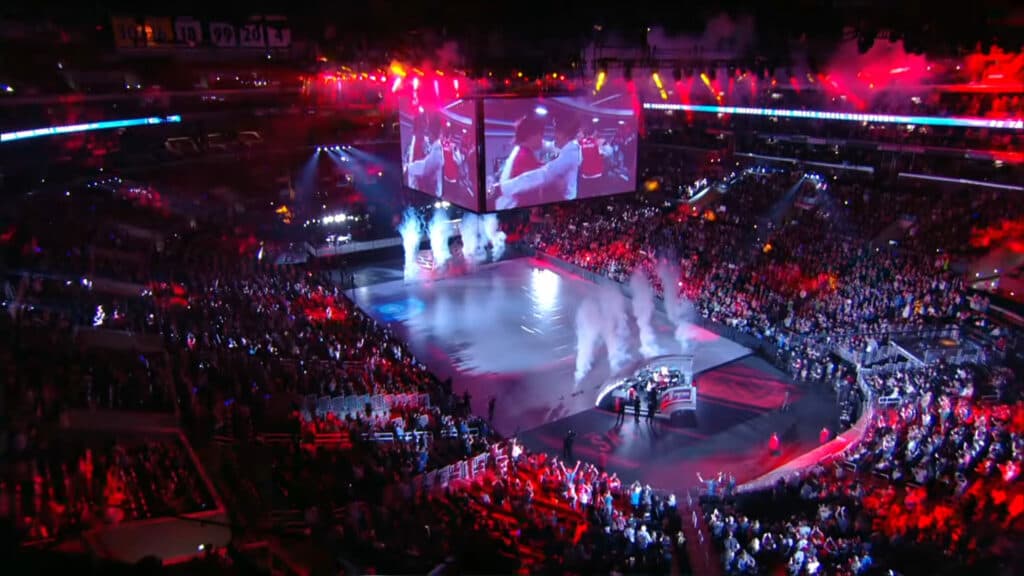An interview with the leaders of Esports Charts about the platform’s rise, how data is collected, and more!
If you're into esports statistics, then you've likely heard of Esports Charts. The site provides data on tournaments, matches, teams, players, and even viewership numbers. It boasts transparency as well, helping organizers, viewers, and sponsors figure out the popularity of esports events across various games.
In an exclusive interview with esports.gg, Esports Charts co-founders Igor Kryvych and Artyom Odintsov alongside head of sales and partnerships Sergii Rudenko shared insights about how Esports Charts was founded, how it works, how events are chosen, and more!

Esports Charts interview
The idea of Esports Charts came about around 2015 and 2016 when the industry started growing at a rapid pace, according to Kryvych. Around that time, the Esports Charts founders began to process viewer data for a number of esports events. This allowed for data comparisons and resulted in the first step in creating a minimum viable product.
Kryvych then revealed that the first tournament that Esports Charts conducted data analysis on was the 2016 League of Legends World Championship.

"Pretty soon, we realized that the analysis of a single broadcast leads, to put it mildly, false analytics, and you need to be able to combine broadcasts together," Kryvych recalled, adding how the event actually resulted in other streams, such as community casting, happening at the same time.
"Within a short period of time, we started to analyze more and more platforms, and now there are more than 25 of them," Kryvych said.

Odintsov talked about the evolution of Esports Charts as well.
"Esports Charts has been analyzing not only esports tournaments, but also music festivals and sports events that were broadcast on livestreaming platforms," he explained. "COVID-19 has greatly increased the amount of such content, so we plan to further separate the analysis of esports and sports events. This will further increase the number of comparisons of esports with the popularity of other non-gaming events."
Some examples of these events may include SpaceX launches, Apple events, or even Eurovision, according to Odintsov.

How does Esports Charts work?
As for how Esports Charts is able to provide accurate data, Kryvych explained the site's winning formula: Esports Charts = Streaming Data + Events Schedule + Up-to-date Analytics.
"If there is someone collecting data from streaming platforms, then it's usually at intervals of five, 10, and 15 minutes," he said. "We do so every 20 to 30 seconds. Volumes and technical complexity grow proportionally, as well as the accuracy of research. We not only state this, but also show our clients methodologies and logs that are completely transparent. Only real data."

Kryvych added that the Esports Charts team is always improving, adding new functionalities, and working closely with customers. It's a meticulous job to process volumes of data and have up-to-date schedules of what's happening around the world.
In terms of event coverage, Kryvych said that the main criteria for adding a tournament to the database is the existence of a live broadcast. Esports Charts also covers scholastic tournaments and smaller events, and it's their dedicated contributors who help with these.
"The only problem for us is the esports market in China," Kryvych acknowledged. "We only cover tournaments that are broadcast on platforms outside of China because Chinese streaming platforms have completely different metrics and methodologies for counting viewers."
"Great ideas come to our minds daily, and we immediately try to bring them to life."
Passion, action, and noble intention
It takes passion to gather esports data as well, and Rudenko acknowledged the hard work of Esports Charts' employees.
"One of the features of our company is the willingness to experiment," he revealed. "Great ideas come to our minds daily, and we immediately try to bring them to life. This does not always bring results, but the support of the company is tangible here. As Tom Hardy once said, “Passion, action, and noble intention creates progress.""
At the same time, the management structure of Esports Charts is horizontal, which helps with making and implementing decisions faster. The company has C-level management, but its managers are directly involved in a variety of processes. This inspires employees as they also see the dedication that management has for the Esports Charts product, Rudenko added.

What makes Esports Charts unique?
A prime example of this level of care is Esports Charts' approach on data. For example, Kryvych talked about how clients always want big numbers and indicators of growth. However, it can be difficult for them to accept low but factual numbers.
"Math has no compassion," Kryvych said. "The problem here is that this may encourage customers to look for those who will give the desired numbers. We condemn this approach as much as possible because it encourages analytical companies to do certain "twisting," conscious or unconscious, without transparent methodologies. In the long term, such frauds bring huge risks for both businesses and the industry as a whole."

Kryvych then gave an example to emphasize why the Esports Charts approach matters — particularly with the hours watched (HW) and minutes watched (MW) metrics.
"HW is mathematically the area under the graph of viewers on the broadcast or the integral of the viewer function," he said. "Depending on the method of data aggregation and the frequency of data collection, the calculation may differ. HW can be also calculated according to the maximums for certain periods of time. This will consistently overestimate this indicator. Customers will be happy, but mathematically, this is not true and will lead to false results and expectations. We do not do this and do not advise [this to] anyone."
The Esports Charts Dashboard
Meanwhile, Rudenko shared some insights about the site's main product, which is the Esports Charts Dashboard. Rudenko noted how the enterprise solution also lets tier-three teams and organizers select relevant metrics and statistics.
"One of the important things many companies in the industry want is the analysis of competitors, which allows them to understand their performance in comparison with others, as well as to prepare comparative analysis for sponsors," Rudenko said. "Most of the analytics for clients are updated daily, and in the case of tier-one teams, they can find out the statistics of their matches and their popularity by language within five minutes after the match."
This database helps users identify promising gaming disciplines in different regions around the world, according to Rudenko.

Since its start in 2016, Esports Charts has established itself as a leading provider of esports statistics, offering transparent data for organizers, viewers, and sponsors alike. Spearheaded by its co-founders and head of sales and partnerships, the site continues to offer valuable insights into the popularity of competitive events.
That's all for now. Stay tuned on esports.gg for more news and updates!